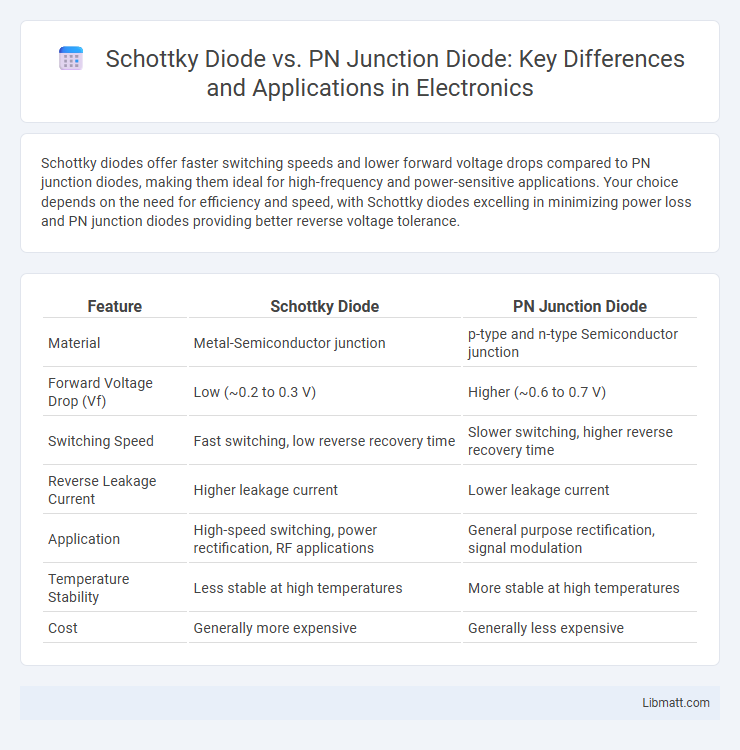Schottky diodes offer faster switching speeds and lower forward voltage drops compared to PN junction diodes, making them ideal for high-frequency and power-sensitive applications. Your choice depends on the need for efficiency and speed, with Schottky diodes excelling in minimizing power loss and PN junction diodes providing better reverse voltage tolerance.
Table of Comparison
| Feature | Schottky Diode | PN Junction Diode |
|---|---|---|
| Material | Metal-Semiconductor junction | p-type and n-type Semiconductor junction |
| Forward Voltage Drop (Vf) | Low (~0.2 to 0.3 V) | Higher (~0.6 to 0.7 V) |
| Switching Speed | Fast switching, low reverse recovery time | Slower switching, higher reverse recovery time |
| Reverse Leakage Current | Higher leakage current | Lower leakage current |
| Application | High-speed switching, power rectification, RF applications | General purpose rectification, signal modulation |
| Temperature Stability | Less stable at high temperatures | More stable at high temperatures |
| Cost | Generally more expensive | Generally less expensive |
Introduction to Schottky and PN Junction Diodes
Schottky diodes are semiconductor devices formed by the junction of a metal and an n-type semiconductor, known for their low forward voltage drop and fast switching speed, making them ideal for high-frequency applications. PN junction diodes consist of p-type and n-type semiconductor materials joined together, exhibiting standard rectifying behavior with higher forward voltage and slower switching compared to Schottky diodes. Understanding the fundamental differences between Schottky and PN junction diodes helps you select the right component for your power and signal processing circuits.
Basic Structure Comparison
Schottky diodes feature a metal-semiconductor junction typically formed between a metal and an n-type semiconductor, resulting in lower forward voltage drop and faster switching speeds. In contrast, PN junction diodes consist of a p-type and n-type semiconductor junction with a depletion region controlling current flow, causing higher forward voltage drop and slower switching. The distinct structural differences directly influence their electrical characteristics and typical applications in circuits.
Working Principle Explained
A Schottky diode operates based on the metal-semiconductor junction, allowing majority carriers to flow rapidly with minimal charge storage, resulting in faster switching speeds and lower forward voltage drop compared to PN junction diodes. In contrast, a PN junction diode functions through the diffusion of charge carriers across a p-n interface, creating a depletion region that controls current flow and causes higher forward voltage and slower switching. The fundamental difference in charge carrier movement and junction type defines their distinct electrical characteristics and performance in high-speed and low-voltage applications.
Forward Voltage Drop Differences
Schottky diodes exhibit a significantly lower forward voltage drop, typically between 0.15 to 0.45 volts, compared to PN junction diodes, which usually have a forward voltage drop around 0.7 volts for silicon-based devices. This lower voltage drop in Schottky diodes results in higher efficiency and reduced power loss in circuits where minimizing voltage drop is crucial. Choosing a Schottky diode can improve your device's performance by enhancing fast switching and reducing heat dissipation due to this characteristic.
Reverse Recovery Time Analysis
Schottky diodes have significantly lower reverse recovery time compared to PN junction diodes due to their metal-semiconductor junction, allowing faster switching and reduced switching losses. PN junction diodes exhibit longer reverse recovery times caused by minority carrier charge storage in the depletion region. This difference makes Schottky diodes ideal for high-frequency and high-speed switching applications where efficiency and thermal performance are critical.
Switching Speed Comparison
Schottky diodes exhibit significantly faster switching speeds than PN junction diodes due to their majority carrier conduction mechanism that minimizes charge storage and reduces recovery time. The switching time of Schottky diodes typically falls in the nanosecond range, whereas PN junction diodes experience microsecond-scale delays because of minority carrier recombination. This makes Schottky diodes ideal for high-frequency applications and power rectification where rapid switching is critical.
Power Dissipation Characteristics
Schottky diodes exhibit lower forward voltage drop (typically 0.2 to 0.3 V) compared to PN junction diodes (approximately 0.7 V), resulting in reduced power dissipation and improved efficiency in high-speed switching applications. Your circuits benefit from increased thermal performance and lower heat generation due to the Schottky diode's minimal forward voltage and faster recovery time. PN junction diodes tend to dissipate more power under forward bias, making Schottky diodes preferable for low-voltage, high-frequency power management tasks.
Common Applications of Each Diode
Schottky diodes are commonly used in high-speed switching applications, power rectification in power supplies, and RF circuits due to their low forward voltage drop and fast recovery time. PN junction diodes are widely employed in general-purpose rectification, signal demodulation, and voltage regulation tasks because of their robust design and higher reverse voltage capabilities. Your choice depends on the need for speed and efficiency versus voltage tolerance in your electronic circuit.
Advantages and Disadvantages
Schottky diodes offer faster switching speeds and lower forward voltage drop (typically 0.2 to 0.3 volts), making them ideal for high-frequency and low-voltage applications, but they exhibit higher reverse leakage current compared to PN junction diodes. PN junction diodes, with a higher forward voltage drop (around 0.7 volts for silicon), provide better reverse recovery characteristics and lower reverse leakage, suitable for rectification and general-purpose use. However, PN diodes have slower switching times, which may limit performance in high-speed circuits.
Choosing Between Schottky and PN Junction Diodes
Schottky diodes offer faster switching speeds and lower forward voltage drops, making them ideal for high-frequency and low-voltage applications, while PN junction diodes provide higher reverse breakdown voltages and better stability under high temperature conditions, suitable for general rectification uses. Selecting between Schottky and PN junction diodes depends on factors like switching speed requirements, voltage ratings, reverse leakage current tolerance, and thermal performance. Engineers prioritize Schottky diodes in power efficiency and high-speed circuits and prefer PN junction diodes for robustness and higher voltage resilience.
Schottky Diode vs PN Junction Diode Infographic

 libmatt.com
libmatt.com